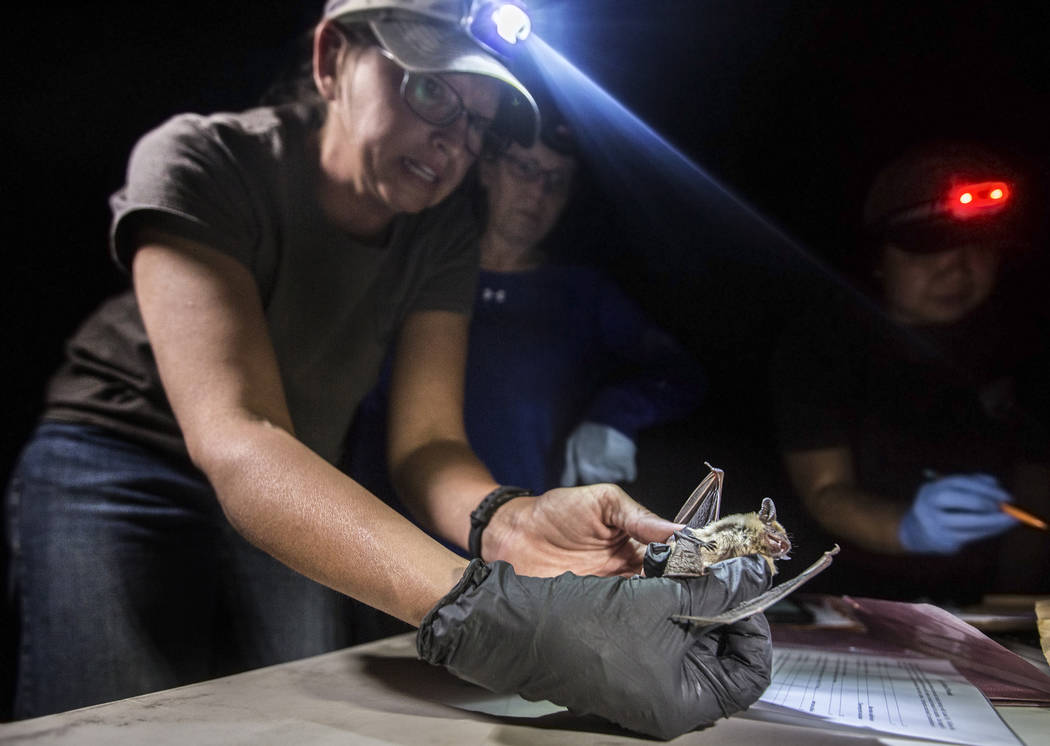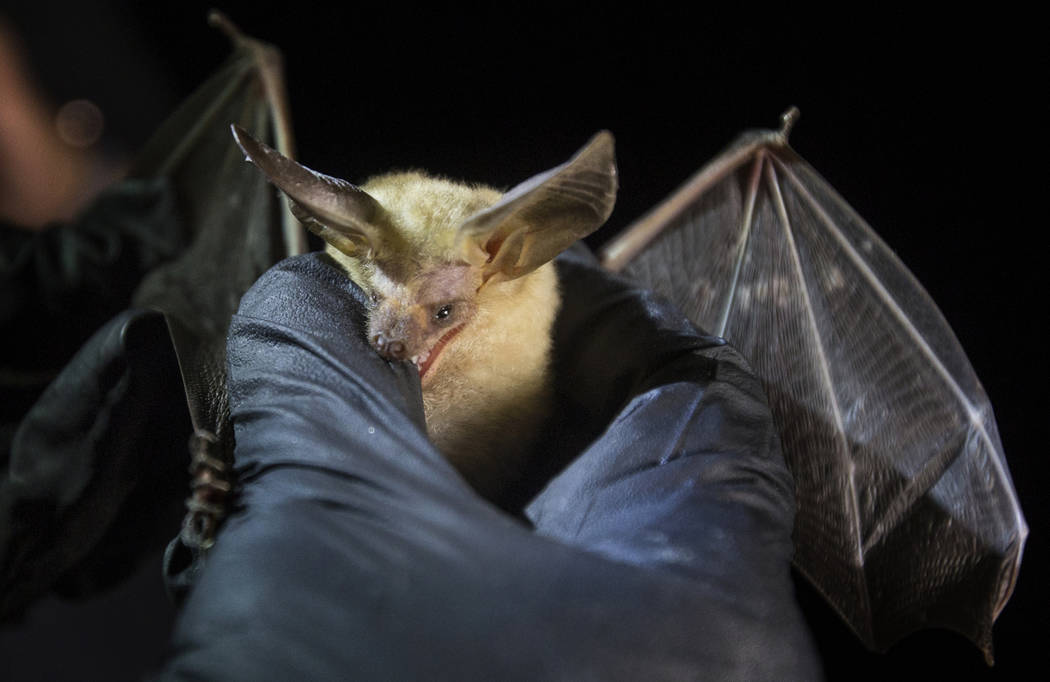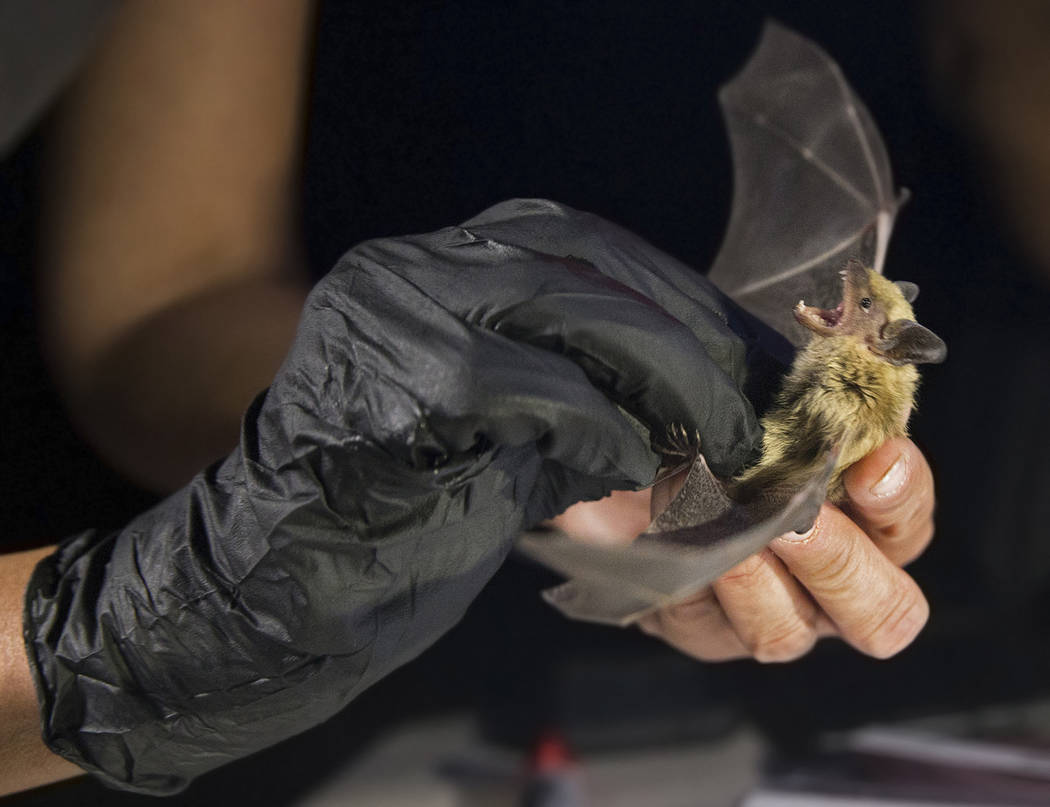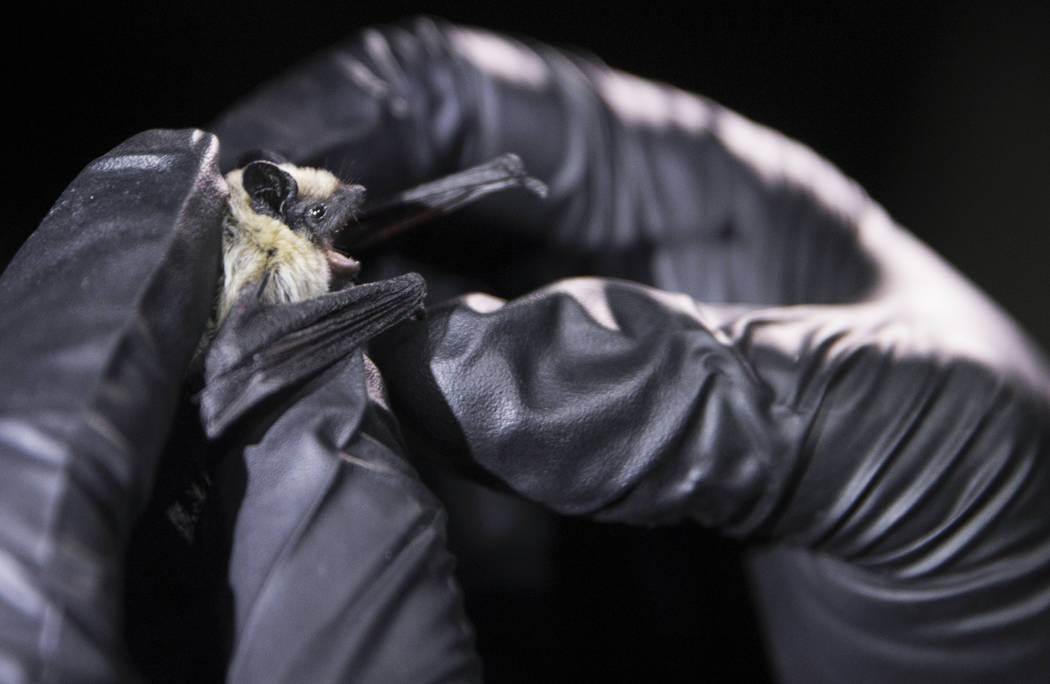In Bat Blitz, researchers check on our nocturnal neighbors in Nevada
A team of researchers fanned out across the desert north of Las Vegas last week in search of bats.
What they found was a sky full of expectant mothers.
Of the 532 bats cataloged during the four-day catch-and-release event, 191 were pregnant females and another 41 had recently given birth.
At one site alone, almost three-quarters of the bats captured Tuesday were female, and all of them had just given birth or were still carrying pups, as baby bats are known.
“Bats are the only mammal capable of flight, and it is quite amazing to think about flying around while pregnant,” said Christy Klinger, a biologist from the Nevada Department of Wildlife.
It gets even more amazing when you consider that pups can weigh about one-quarter as much as their mothers when they are born.
“That would be like a 150-pound woman giving birth to a 37.5 pound baby,” she said.
Klinger organized last week’s Bat Blitz, an annual survey by experts from local, state and federal agencies.
Filling in blank spots
Klinger said the goal of the blitz is to bring together “bat professionals” from across the region to “fill in a blank spot on the map” where little is known about bat activity.
Such blank spots are not hard to find, she said. “We have a dearth of data.”
The blitz also serves as a training opportunity for biologists looking to expand their bat knowledge. “It’s not every day that you can handle bats and get that experience,” Klinger said.
This year’s event focused on 28 survey sites across Southern Nevada and northwestern Arizona.
Tuesday’s outing included 52 people at 10 different sites in and around the Mormon Mountains of southern Lincoln County, about 75 miles northeast of Las Vegas.
They headed into the mountains in a convoy of 13 vehicles that turned off of Interstate 15 and rumbled northwest on a dirt road at about 5:45 p.m.
Klinger and her seven-person team set up shop on a brush-covered hilltop next to a pair of rusty cattle troughs, where they strung two, fine-gauge curtains of netting above the only reliable water source for miles.
A thick cloud of unrelenting gnats attacked them while they worked.
The first bats appeared at dusk as flitting silhouettes against the darkening sky.
“Blind as a bat” is an old wives’ tale, Klinger said. Even in the fading light, the bats could easily see the nets with their eyes, and with echolocation they could easily detect each individual strand, she said.
‘They are having a heyday’
Klinger used an infrared camera to illustrate her point. A quick look through the viewfinder showed bat after bat swooping down on the stock tanks, only to peel away just before getting caught in the net.
Nearby, a sensitive listening device clicked and lit up as the bat’s ultrasonic pulses were converted into sounds that humans can hear.
Occasionally the clicks would give way to a longer, sustained noise that Klinger called a “feeding buzz” or “terminal buzz.” It’s a sound the bats make to precisely target their prey just before they strike.
“They are having a heyday right now,” Klinger said as her listening device crackled like a Geiger counter in the bug-filled air.
Meanwhile, another listening device connected to a computer sorted out the bats by species using their inaudible squeaks.
“Each bat has a unique echolocation signature, so to speak,” Klinger said.
The team’s first capture came at 8:31 p.m., roughly half an hour after sunset — a pregnant female canyon bat with worn-down teeth that hinted at her age.
“It takes a lot of bugs to wear down your teeth like that,” Klinger said. “She’s an old bat. She’s been around a long time.”
Over the next four hours, they would catch 24 bats representing at least six different species.
Each bat was examined by hand and then tucked into a paper lunch sack to be weighed. Before being released, each was marked on its back with a red Sharpie so the researchers would know if they caught the same bat twice.
Klinger said the other teams were assigned different Sharpie colors, just in case a bat from one site turned up in the net at another.
“We rarely get recaptures,” she said, but it does happen.
Looking for deadly fungus
Blitz participants were also on the lookout for signs of white-nose syndrome, a deadly fungus-borne disease that attacks bat colonies during hibernation.
It was first documented in upstate New York in 2006 and has slowly spread west, killing 90 to 100 percent of bats at some sites.
Bats can live up to 30 years in the wild, and they generally only produce one pup a year, Klinger said, so something like a major disease outbreak can have long-lasting population-level impacts.
The fungus that causes white-nose syndrome can be spread by both bats and cave-exploring humans, which is one reason the Bat Blitzers use copious amounts of hand sanitizer after handling each test subject.
To date, no cases of the disease have been reported in Nevada, but Klinger does not expect that to last.
“I hate to be pessimistic, but it’s not a case of if but maybe when,” she said. “We’re all sort of bracing for that.”
Klinger has been studying bats for the past 19 years, but her fascination with them began when she was a little girl growing up in Iowa.
She said the world’s only flying mammals have been saddled with a lot of negative stereotypes, but they play a crucial role for people and the environment. When they’re not consuming tons of agricultural pests, bats serve as key pollinators for some highly valued crops, including the agaves grown in Mexico to make tequila.
“If we had a world without bats, food would cost way more,” Klinger said.
Nevada is home to 23 different species ranging from the mouse-sized canyon bat to the Western mastiff, which has a wingspan of almost 2 feet. A colony of Mexican free-tailed bats has lived in the employee parking garage at McCarran International Airport for decades.
But even though bats make up one-quarter of all mammals on the planet, their elusive, nocturnal lifestyle largely keeps them hidden from view.
“In general, bats are hard to study,” Klinger said. “For that reason, they are under-studied and under-appreciated.”
Contact Henry Brean at hbrean@reviewjournal.com or 702-383-0350. Follow @RefriedBrean on Twitter.
Bat Blitz by the numbers
532
bats captured and released during a four-night survey last week by the Nevada Bat Working Group.
13
different species cataloged during the Bat Blitz.
28
different sites where bats were netted in Southern Nevada and Northwestern Arizona. One site caught 69 bats over a four-hour period, another caught none.
307
female bats caught during the blitz, including 41 that had recently given birth and 191 that were flying around pregnant.











































